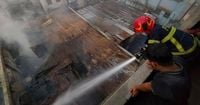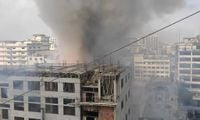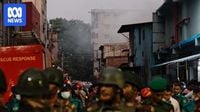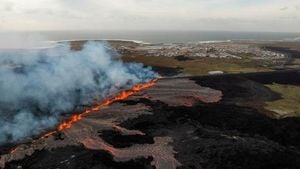On October 14, 2025, the bustling Mirpur district of Dhaka, Bangladesh, was rocked by a devastating fire that tore through a garment factory and an adjacent chemical warehouse, leaving at least 16 people dead and many others unaccounted for. As the sun climbed above the city, what began as an ordinary workday for hundreds of factory workers and warehouse staff quickly turned into a nightmare that would grip the nation and reignite urgent questions about industrial safety in one of the world’s most important garment-producing countries.
According to the Bangladesh Fire Service and Civil Defense, the blaze erupted around 11 a.m. on the third floor of a seven-story garment factory. Within minutes, flames spread rapidly, fueled by highly flammable materials stored both in the factory and the neighboring chemical warehouse. Witnesses reported a sudden explosion as the fire reached the warehouse, which was later revealed to contain bleaching powder, plastic, and hydrogen peroxide — chemicals notorious for intensifying fires and producing toxic fumes.
Firefighters, led by Brigadier General Muhammad Zahed Kamal, battled the inferno for hours. By evening, the fire in the factory was under control, but the warehouse continued to smolder, spewing heat and smoke that complicated rescue efforts. Kamal told reporters, “It may take several days,” emphasizing that chemical reactions at the site continued to produce hazardous conditions. Firefighters, wary of the unknown contents inside the warehouse, deployed drones and specialized technology to locate the source of the flames, a lesson learned from a similar disaster in 2022 that claimed the lives of several first responders.
The human cost of the tragedy was immediately apparent. Sixteen bodies were recovered from the upper floors of the factory, all so badly burned that authorities said DNA testing would be required to identify them. “Sixteen bodies have been recovered and would be handed to families after DNA testing, as they have been burnt beyond recognition,” the fire service told BBC and other outlets. The remains were transported to a Dhaka hospital for identification, while distraught families gathered outside the cordoned-off site and nearby hospitals, clutching photographs and searching desperately for missing loved ones. The scene was heart-wrenching: men and women weeping, some calling out names, others simply waiting for any scrap of news.
Among those searching was a father, his voice breaking as he spoke to Reuters: “When I heard about the fire, I came running. But I still haven’t found her... I just want my daughter back.” Another man, Mohammad Nayeem, told The New York Times he was looking for his wife, Samia Akter, a garment worker. “I went twice to Dhaka Medical, but couldn’t find her. I still don’t know where she is.”
The tragedy was compounded by evidence of egregious safety violations. Fire service director Mohammad Tajul Islam Chowdhury explained that most deaths were caused by the inhalation of toxic gas, with victims likely dying “instantly” after breathing in “highly toxic gas.” The situation was made worse by a locked roof door, which prevented workers from escaping to safety. “Most of the deaths were caused by toxic gas and the building’s roof door being locked,” Chowdhury told local media, underscoring a recurring theme in Bangladesh’s industrial disasters.
As the fire raged and its aftermath unfolded, attention quickly turned to the legality and safety of the facilities involved. The chemical warehouse, it was revealed, had no fire safety clearance, no license from the fire department, and no official occupancy certificate. Local officials confirmed to BBC and AP that the warehouse was operating illegally, raising questions about regulatory oversight and enforcement in Dhaka’s densely packed industrial zones. Police and military officers launched a search for the owners of both the factory and the warehouse, who had yet to be identified or located as of the following day. An investigation into the cause of the fire and the legality of the warehouse’s operations was underway, but answers remained elusive.
Bangladesh’s garment industry is a global powerhouse, second only to China in terms of exports, and employs about 4 million people—most of them women. The sector generates approximately $40 billion annually, supplying major retailers in the United States and Europe. Yet, as AP and BNO News noted, the industry has long been plagued by industrial accidents, fires, and building collapses, often attributed to lax monitoring, poor infrastructure, and flagrant violations of building codes.
The country’s deadliest industrial disaster remains the 2013 collapse of the Rana Plaza building, which housed several garment factories and killed more than 1,100 people. That tragedy sparked international outrage and led to sweeping reforms and safety improvements, yet deadly incidents have continued to occur. In 2021, a fire at a food and drink factory killed at least 52 people, and in 2019, a fast-moving blaze in a historic Dhaka district claimed 78 lives. Despite some progress in working conditions and oversight, the events of October 14, 2025, serve as a grim reminder that much work remains to be done.
“Large fires are relatively common in densely populated Bangladesh, often due to lax safety standards and poor infrastructure,” BBC reported. Hundreds have died in similar incidents in recent years, and each tragedy brings renewed calls for accountability and reform. The Mirpur fire, with its combination of hazardous chemicals, locked exits, and absent owners, has again exposed the vulnerabilities at the heart of Bangladesh’s industrial engine.
As the smoke finally begins to clear over Mirpur, families continue to wait—some for answers, others for closure, and all for change. The search for missing workers goes on, as does the investigation into how such a disaster could happen again in a country all too familiar with industrial grief. For the survivors and the families of the lost, the scars of this fire will linger long after the headlines fade.






